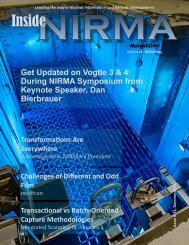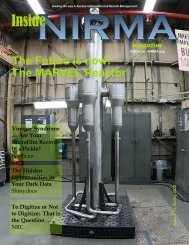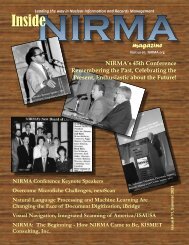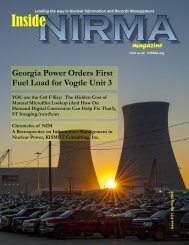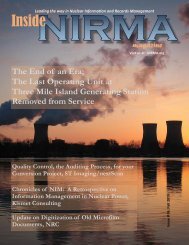Inside NIRMA Spring 2021
Create successful ePaper yourself
Turn your PDF publications into a flip-book with our unique Google optimized e-Paper software.
Defining Microfilm<br />
“Production Scanner”<br />
By Matt Anderson,<br />
Vice President of Marketing, nextScan<br />
L<br />
ately there has been a lot of<br />
talk about “Production”<br />
scanners within the microfilm<br />
market, but what does that actually<br />
mean? According to Isausa, inc.<br />
President Manuel Bulwa,<br />
“Document capture industry experts<br />
share a general consensus around the<br />
concept of “Production” level status<br />
as an elusive threshold that separates<br />
low to high volume document<br />
capture.” And by volume, that is<br />
more than how many images per<br />
minute, think a month. With that in<br />
mind, we thought we would share<br />
our professional opinion to help you<br />
pinpoint key identifiers that<br />
differentiate a production scanner<br />
from an on-demand scanner.<br />
Two Basic Kinds of<br />
Microfilm Scanners<br />
When you break it down, there<br />
are two “classes” of microfilm<br />
scanners:<br />
• Production and<br />
• On-Demand<br />
Production<br />
scanners are<br />
machines that are<br />
built using<br />
sophisticated lighting and line-scan<br />
sensors to convert microfilm to<br />
digital format permanently, in one<br />
scan. On-Demand scanners are the<br />
devices equipped with area-scan<br />
sensors that are employed to capture<br />
images from microfilm on an “as<br />
needed basis” - one image at a time.<br />
Someone would not use a<br />
Production scanner to scan one<br />
image at a time, same as someone<br />
would not use an On-Demand<br />
scanner to convert an entire roll of<br />
microfilm. These scanners have been<br />
designed for two separate and<br />
distinct processes.<br />
Production level scanners are<br />
designed from the ground up to<br />
simultaneously transport and capture<br />
high-resolution images on microfilm<br />
or microfiche. Production scanners<br />
are built with a highly specialized line<br />
scanning image sensor, top-of-theline<br />
lenses for greater focal depth,<br />
and lighting technology that enables<br />
high-speed digital conversion of the<br />
media. This allows for the film, or<br />
fiche, to be captured at the highest<br />
resolutions while traveling at<br />
extremely high speeds. Due to their<br />
reliability, and image quality,<br />
production scanners are always<br />
favored by conversion service<br />
bureaus, the document capture<br />
experts that scan all sorts of<br />
documents professionally.<br />
On-Demand, also known as<br />
research or walk-up microfilm<br />
scanners, are designed to offer a<br />
digital solution to replace the old and<br />
outdated analog microfilm readerprinters.<br />
The On-Demand scanners<br />
are most popular with patrons of<br />
libraries around the world, both in<br />
public and university settings<br />
because they are easy to use. The On<br />
-Demand scanner is limited to still<br />
image capture. These scanners are<br />
equipped with a light source and<br />
Complementary Metal Oxide<br />
Semiconductor (CMOS) image<br />
sensor like what you would find in a<br />
digital camera, limiting the user to<br />
capture each image on microfilm one<br />
at a time.<br />
Microfiche Scanning<br />
Challenges<br />
The flat, card-like style of<br />
microfiche presents its own<br />
Continued on next page.<br />
Back to Content | <strong>Inside</strong> <strong>NIRMA</strong> <strong>NIRMA</strong>.org <strong>Spring</strong> <strong>2021</strong> 7









